A mass for asymptotically complex hyperbolic manifolds
A mass for asymptotically complex hyperbolic manifolds
A mass for asymptotically complex hyperbolic manifolds
Create successful ePaper yourself
Turn your PDF publications into a flip-book with our unique Google optimized e-Paper software.
hal-00429306, version 1 - 2 Nov 2009<br />
A MASS FOR ASYMPTOTICALLY COMPLEX HYPERBOLIC MANIFOLDS. 13<br />
the components of an element of N). Denoting the real part of zk by xk, one can check<br />
that the corresponding element of N0(CH m ) ∼ = Λ 2 J,0 R2m,2 is<br />
l−1<br />
βϕa = − Jdxaj ∧ dxaj +<br />
j=1<br />
l<br />
Jdxăj ∧ dxăj + Jdxm+1 ∧ dxm+1<br />
j=1<br />
(To see this, it is sufficient to compute the scalar product of the right-hand side with<br />
Jν ∧ ν and observe that it coincides with π∗uϕa.) In particular, < βϕa,βϕ a >= m + 1.<br />
All these two-<strong>for</strong>ms belong to the same orbit of the isometric and holomorphic action<br />
of PU(m,1). We will denote this orbit by N +<br />
0,CHm. Note that, since Λ2 J,0R2m,2 is<br />
an irreducible representation of PU(m,1), the linear span of N +<br />
0,CHm is the whole<br />
Λ2 J,0R2m,2 .<br />
3. Toward a <strong>mass</strong>.<br />
3.1. The “<strong>mass</strong> integral” at infinity. Let us give a precise definition <strong>for</strong> the class<br />
of <strong>manifolds</strong> we are interested in.<br />
Definition 3.1 — A complete Kähler manifold (Mm ,g,J) is called <strong>asymptotically</strong><br />
<strong>complex</strong> <strong>hyperbolic</strong> if there is a compact subset K of M and a ball B in CHm such<br />
that:<br />
(i) (M\K,J) is biholomorphic to CHm \B and,<br />
(ii) through this identification, ear (g −gCH m) is bounded in C1,α , with respect to the<br />
<strong>complex</strong> <strong>hyperbolic</strong> metric gCHm. Here, r denotes the distance to some point in<br />
CHm and we assume a > m + 1<br />
2 .<br />
In [Her], it is only assumed that the <strong>complex</strong> structure J of M is asymptotic to the<br />
<strong>complex</strong> structure J0 of CHm (instead of J = J0, as in our definition). It turns out that,<br />
if J is asymptotic to J0, then they are related by a biholomorphism, defined outside a<br />
compact set and asymptotic to the identity. To justify this, let us see J and J0 as two<br />
<strong>complex</strong> structures on a neighborhood U of S2m−1 in the unit ball of Cm . Under our<br />
assumptions, they induce the same CR structure on the unit sphere, the standard CR<br />
structure of S2m−1 . The restriction of any J0-holomorphic coordinate zk to the sphere<br />
is a CR function. Since the standard sphere is strictly-pseudo-convex, Lewy’s extension<br />
theorem makes it possible to extend this function into a J-holomorphic function wk<br />
on U (shrinking U if necessary). This yields a holomorphic map w = (w1,...,wm)<br />
from Ω to Cm . Since z = (z1,... ,zm) is a diffeomorphism onto its range and coincide<br />
with w on the sphere, we may shrink U to ensure w is also a diffeomorphism onto its<br />
range, hence a biholomorphism between two neighborhoods of S2m−1 in the unit ball<br />
of Cm , one endowed with J and the other one with the standard <strong>complex</strong> structure.<br />
The promised biholomorphism is z−1 ◦ w.<br />
In this section, we assume (M,g,J) is an <strong>asymptotically</strong> <strong>complex</strong> <strong>hyperbolic</strong> manifold<br />
of odd <strong>complex</strong> dimension m = 2l−1 and with scalar curvature bounded from below by<br />
−4m(m + 1) (the scalar curvature of CHm ). In this setting, the spinor bundle Σ| M\K<br />
can be identified with the spinor bundle of CHm \B. We may there<strong>for</strong>e extend any<br />
Kählerian Killing spinor φ on CHm \B into a spinor φ on M. Our aim is to understand<br />
to what extent we can make it into a Kählerian Killing spinor. In the spirit of [Wit],<br />
we first check that we can choose an extension in the kernel of a Dirac operator.<br />
Lemma 3.2 — There is a smooth spinor ψ := φ + φerr such that Dψ = 0 and φerr<br />
decays as e −br in C 1,α with b > m + 1<br />
2 .




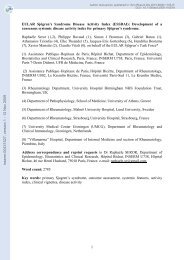
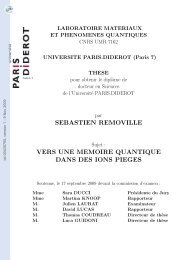
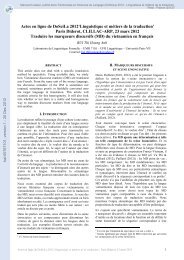
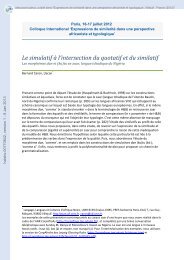
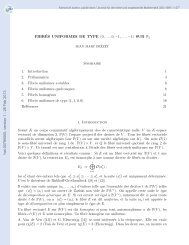
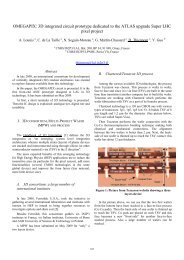
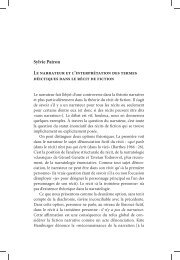
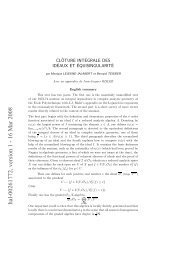
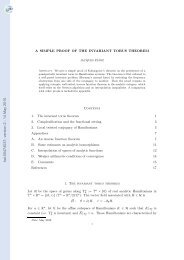

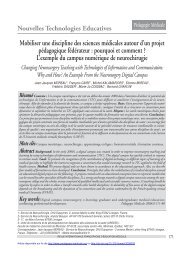

![[tel-00433556, v1] Relation entre Stress Oxydant et Homéostasie ...](https://img.yumpu.com/19233319/1/184x260/tel-00433556-v1-relation-entre-stress-oxydant-et-homeostasie-.jpg?quality=85)